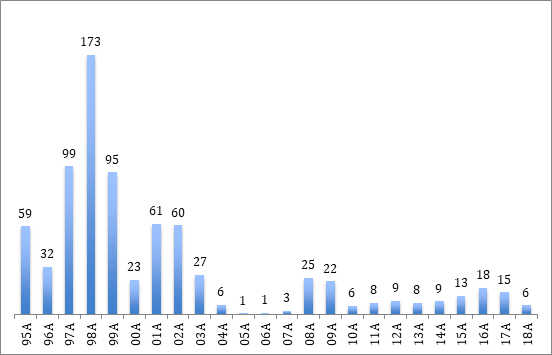
In this briefing:
- Hitachi High Tech’s Ace in the Hole
- Bank Alfalah: Metrics Point to Falāh
- Philippines: February Inflation Eases Back to BSP’s Inflation Target Range
- China Tower Results Confirm Lower Capex Outlook, but Were Otherwise Mixed
- King’s Town: “The Night Seems to Fade, but the Moonlight Lingers On”
1. Hitachi High Tech’s Ace in the Hole

Last Friday, Hitachi (6501) was reported to be considering selling Hitachi Chemical (4217), according to media sources over the weekend. This has sent Hitachi Chemical and its parent into a frenzy with Hitachi Chemical ADR up 13% last Friday. We believe this news is relevant for Hitachi High Tech because both subsidiaries are 51-52% consolidated by the parent Hitachi, and both have arguably businesses with little synergy with the parent. We believe that Hitachi High Tech is also rumored to be on the block for sale or spin-off. Media sources say that Hitachi is considering a sale of Hitachi Chemical and would reap Y300bn. The current value of their 51% ownership in Hitachi Chemical is Y211bn, and thus there is 42% implied upside if the Y300bn figure is achieved.
To recap Q3 results for Hitachi High Tech from January 31, 2019, the numbers were decent with earnings above consensus forecasts by 33% for Q3 (Y15.8bn OP versus Y13.8bn forecast). The profit rise was due to improved margins in medical and continued strength in process semiconductor equipment. The shares are up 20% year-to-date, outperforming the Nikkei by 15%. Some of the fears of a sharp slowdown in semiconductor have been nullified by the continued strength in logic chip investments as well as the improved profitability in medical clinical analyzers. Medical profits soared 46% YoY in Q3 to Y7.6bn on a 13% YoY increase in revenues. OP margin improved from 12.3% to 15.8% YoY.
2. Bank Alfalah: Metrics Point to Falāh
Bank Alfalah (BAFL PA) is heading in the right direction as testified by its metric progression, embodied in its quintile 1 PH Score™.
Valuations are not stretched – especially the Total return Ratio of 1.8x and an Earnings Yield of 14.5%.
Combining the fundamental momentum signals (PH Score™) with franchise valuation, and a low RSI, places BAFL PA in the top decile of bank opportunities globally.
3. Philippines: February Inflation Eases Back to BSP’s Inflation Target Range

- Better-than-expected February inflation of 3.8%YoY wasn’t just a ‘base effect’ result. Broad food and transport CPI readings probably benefited from a year-ago, statistical high. It’s not the same for most of the non-food CPI items like rental & household utilities, and restaurant & miscellaneous goods & services that comprise discretionary expenditures. Lacking the base effect, inflation within this group seemed to have shed off last year’s price catalysts led by TRAIN’s excise hikes, high oil prices and supply shocks.
- Based on the PSA’s seasonally adjusted data, headline inflation’s annualized pace was a benign 1.2%.
- Our updated monthly time series extrapolation showed headline inflation bottoming out at 1.3%YoY-1.4%YoY in September-October this year.
- Sustained liquidity tightness amid inflation’s benign pace with a trajectory settling in the BSP’s target range could facilitate a staggered bank reserve ratio cut of 2% starting 2Q19.
- With the pro-growth bias of newly appointed BSP chief Benjamin Diokno (former Budget Secretary), the likelihood of a 25bp policy rate cut has been elevated in 3Q19 when inflation this year is expected to hit rock bottom and the ensuing size of positive, real interest rates could risk threatening growth.
- Considering potential macro upsides this year, e.g., inflation bottoming out alongside consumption recovery, buying risk assets on dips is still the norm.
4. China Tower Results Confirm Lower Capex Outlook, but Were Otherwise Mixed

China Tower (788 HK) reported 4Q18 results that looks slightly disappointing. However, they did deliver strong net profit, confirmation that capex is likely to materially undershoot guidance, and the first dividend for the company. However, while that is positive, there were areas of disappointment, with weaker revenue growth and EBITDA.
Our view remains that China Tower’s shares are relatively undervalued and expect share prices to continue to move higher over time, as the stock reflects its inflecting ROIC. It remains our favored name in China given the risks of policy driven over-investment into 5G (see Chinese Telcos: Rising 5G Capex Risk Leads to Another Downgrade).
5. King’s Town: “The Night Seems to Fade, but the Moonlight Lingers On”
King’S Town Bank (2809 TT) flags up some amber signals with the growth of funding and credit costs, huge asset writedowns on financial assets, and a shrinking bottom line that barely resembles Comprehensive Income.
This all may signal a management team getting to grips with some asset problems and navigating the ship into calmer waters. Or is the bank being cleaned up for sale? The bank was rumoured to be interested in Entie Commercial Bank (2849 TT).
Our PH Score™ (our fundamental trend and value-quality indicator) though is subpar at 2.5 (bottom quintile globally) and the RSI (14 day) is high at 77. We would prefer to see an elevated PH Score™ and a low RSI. “If a business does well, the stock will follow”. We are intrigued.
If the bank was trading on a Franchise Valuation of 8% (Asia Pacific median including Japan), shares might be more compelling. But Market Cap./Deposits stands at 20%. The median P/Book in the region (including Japan) stands at 0.8x versus 1.1x at King’s Town.
Get Straight to the Source on Smartkarma
Smartkarma supports the world’s leading investors with high-quality, timely, and actionable Insights. Subscribe now for unlimited access, or request a demo below.























